MERCEDES-BENZ G-CLASS SUV 2016 Owner's Guide
Manufacturer: MERCEDES-BENZ, Model Year: 2016, Model line: G-CLASS SUV, Model: MERCEDES-BENZ G-CLASS SUV 2016Pages: 261, PDF Size: 6.01 MB
Page 31 of 261
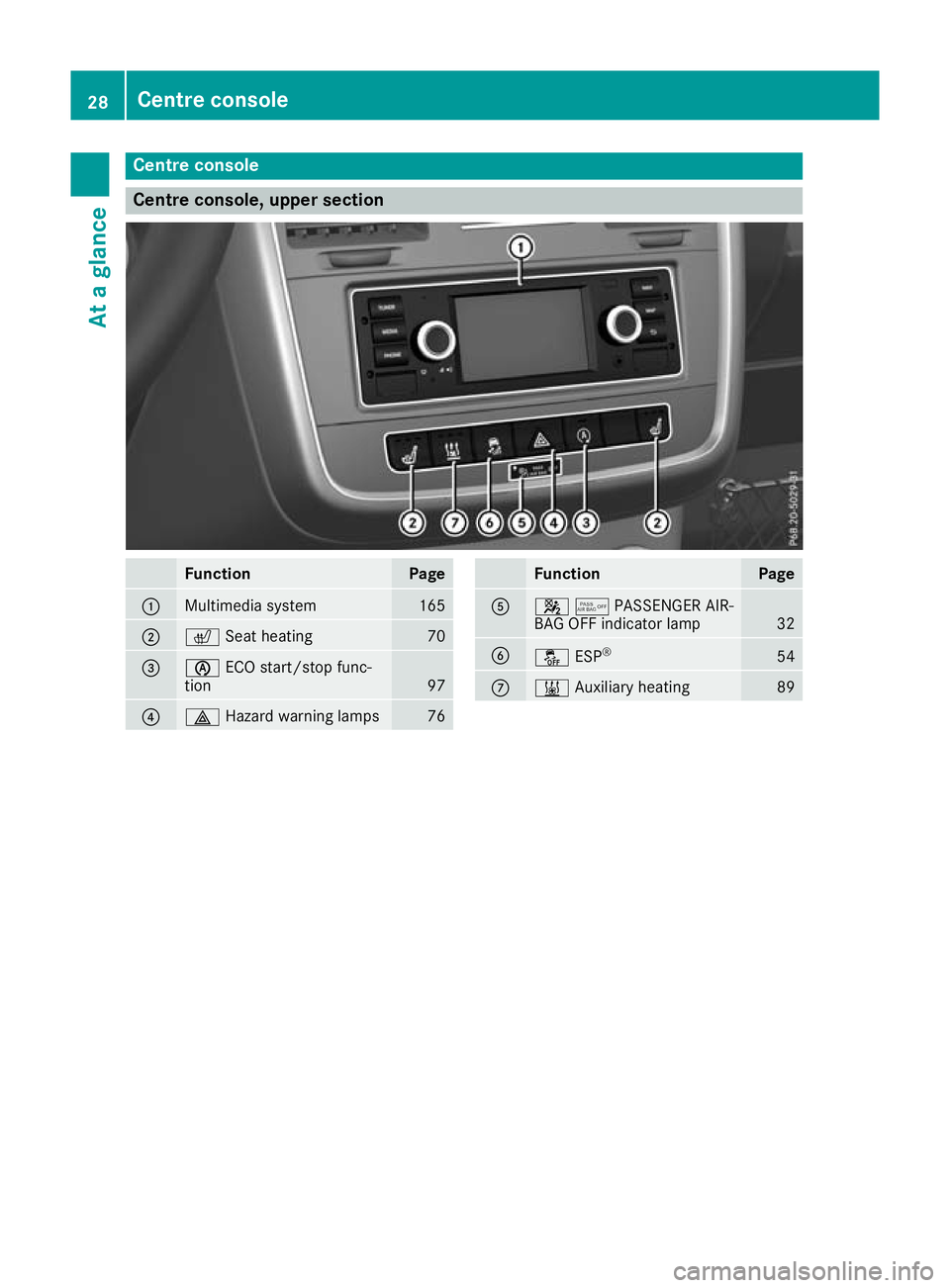
Centre console
Centre console, upper section
Function Page
:
Multimedi
asystem 165
;
c
Seat heating 70
=
è
ECO start/stop func-
tion 97
?
£
Hazard warning lamps 76 Function Page
A
45PASSENGER AIR-
BAG OFF indicator lamp
32
B
å
ESP® 54
C
&
Auxiliary heating 8928
Centre consoleAt
ag lance
Page 32 of 261
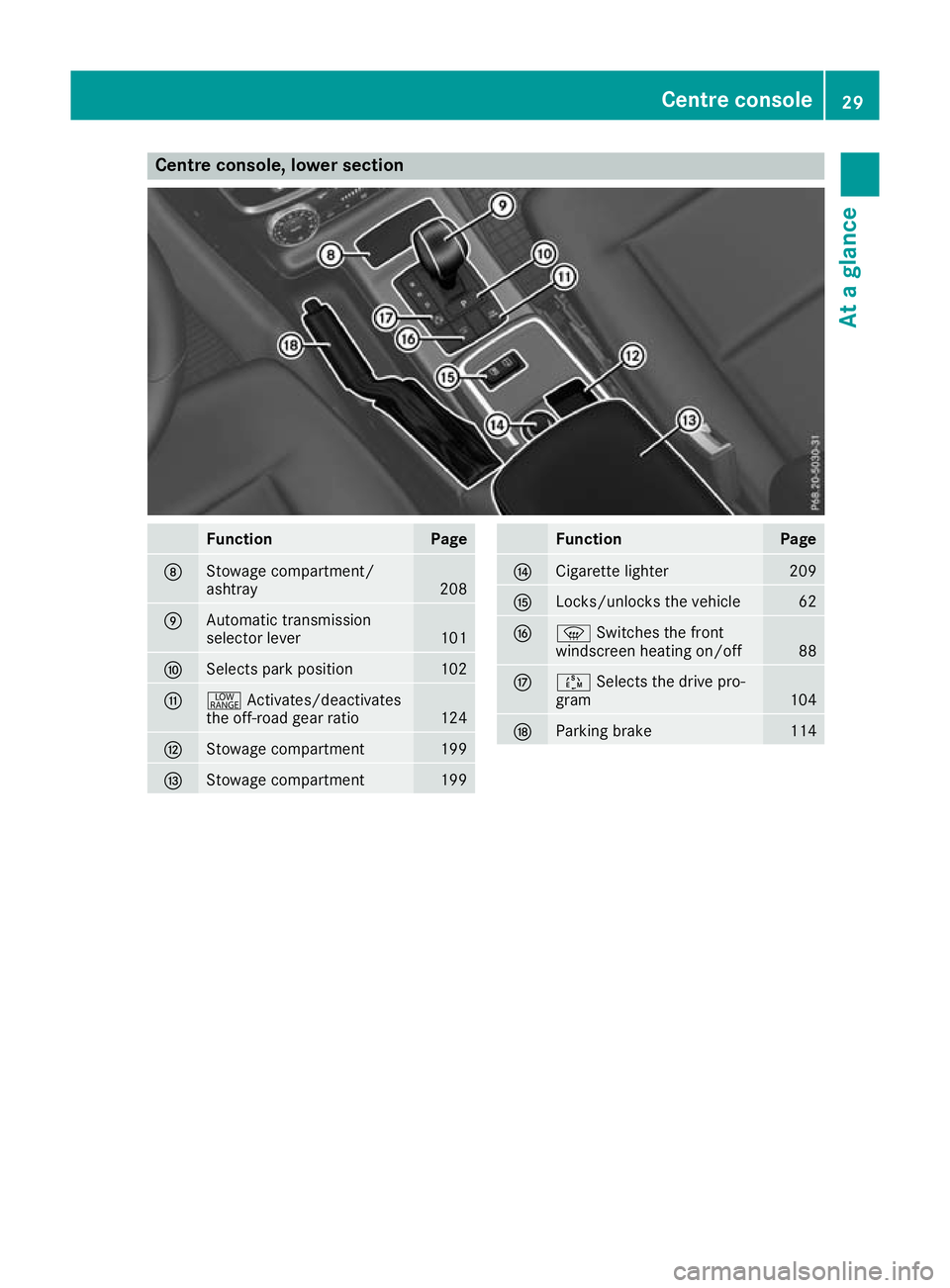
Centre console, lower section
Function Page
D
Stowage compartment/
ashtray
208
E
Automati
ctransmission
selecto rlev er 101
F
Selects park position 102
G
+
Activates/deactivates
the off-roa dgearratio 124
H
Stowage compartment 199
I
Stowage compartment 199 Function Page
J
Cigarette lighter 209
K
Locks/unlock
sthe vehicle 62
L
z
Switches the front
windscreen heating on/off 88
M
Ú
Selects the drive pro-
gram 104
N
Parkin
gbrake 114Centrec
onsole
29Atag lance
Page 33 of 261

Overhea
dcontrol panel Function Page
:
p
Switches the left-hand reading lamp on/off 77
;
c
Switches the front interior lighting on 77
=
u
Switches the luggage compartment/rear interior lighting
on/off 77
?
|
Switches the front interior lighting/automatic interior
lighting contro loff 77
A
p
Switches the right-hand reading lamp on/off 77
B
¡
Opens/closes the sliding sunroof 65
C
Rear-view mirror 7330
Overhead contro
lpan elAt ag lance
Page 34 of 261
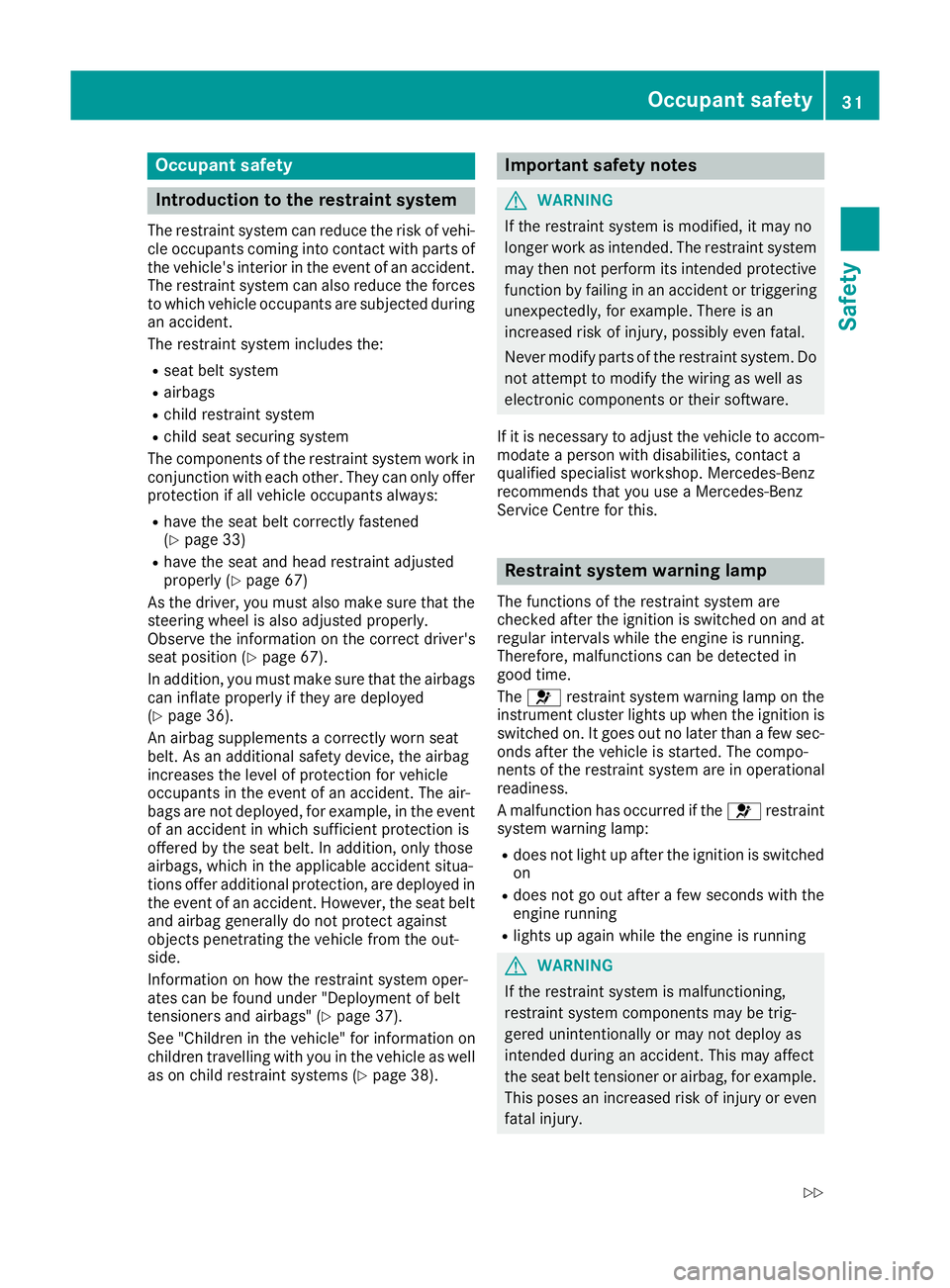
Occupant safety
Introduction to the restraint system
The restraint system can reduce the risk of vehi- cle occupant scom ingi ntoc ontac twithp artsof
th ev ehicle's interio rintheevent of an accident.
The restrain tsystem can also reduce th eforces
to whic hvehicl eoccupant sare subjecte dduring
an accident.
The restrain tsystem includes the:
R seat belt system
R airbags
R child restrain tsystem
R child seat securin gsystem
The component softherestrain tsystem wor kin
conjunction wit heacho ther.T hey can only offer
protection if all vehicl eoccupant salways:
R have th eseat belt correctl yfastened
(Y page 33)
R have th eseat and head restrain tadjusted
properly (Y page 67)
As th edriver, you must also mak esuret hatthe
steering whee lisalso adjusted properly.
Observ ethe information on th ecorrect driver's
seat position (Y page 67).
In addition ,you must mak esuret ha tthe airbags
can inflat eproperly if they are deployed
(Y page 36).
An airbag supplement sacorrectly wornseat
belt .Asana dditional safet ydevice ,the airbag
increases th elevel of protection for vehicle
occupant sintheevent of an accident. The air-
bags are no tdeployed, for example, in th eevent
of an acciden tinwhichs ufficien tprotection is
offere dbytheseat belt .Inaddition ,onlyt ho se
airbags, whic hintheapplicable acciden tsitua-
tion soffer additional protection ,are deployed in
th ee vent of an accident. However, th eseat belt
and airbag generally do no tprotect against
objects penetrating th evehicl efromt heout-
side.
Information on how th erestrain tsystem oper-
ate scan be foun dunder "Deploymen tofbelt
tensioners and airbags" (Y page 37).
Se e" Children in th evehicle" for information on
children travellin gwithy ou in th evehicl easw ell
as on child restrain tsystems (Y page 38). Important safety notes
G
WARNING
If th erestraint system is modified, it may no
longer work as intended. The restraint system
may then not perform its intended protective function by failing in an accident or triggering
unexpectedly,f or example. There is an
increased risk of injury ,possibly even fatal.
Never modify parts of the restraint system. Do not attempt to modify the wiring as wellas
electronic components or their software.
If it is necessary to adjust the vehicl etoaccom-
modate aperso nwith disabilities, contact a
qualified specialist workshop. Mercedes-Benz
recommends that you use aMercedes-Benz
Service Centre for this. Restraint system warnin
glamp
The functions of the restraint system are
checke dafterthe ignition is switched on and at
regular interval swhile the engine is running.
Therefore, malfunctions can be detected in
goo dtime.
The 6 restraint system warning lamp on the
instrument cluster lights up when the ignition is switched on. It goe soutno later than afew sec-
onds afte rthe vehicl eisstarted. The compo-
nents of the restraint system are in operational
readiness.
Am alfunction ha soccurred if the 6restraint
system warning lamp:
R doe snot light up afte rthe ignition is switched
on
R doe snot go ou tafte raf ew seconds with the
engine running
R lights up agai nwhile the engine is running G
WARNING
If the restra ints ystem is malfunctioning,
restraint system components may be trig-
gered unintentionally or may not deploy as
intended during an accident. This may affect
the seat beltt ensioner or airbag, for example.
This poses an increased risk of injury or even
fatal injury. Occupant safety
31Safety
Z
Page 35 of 261
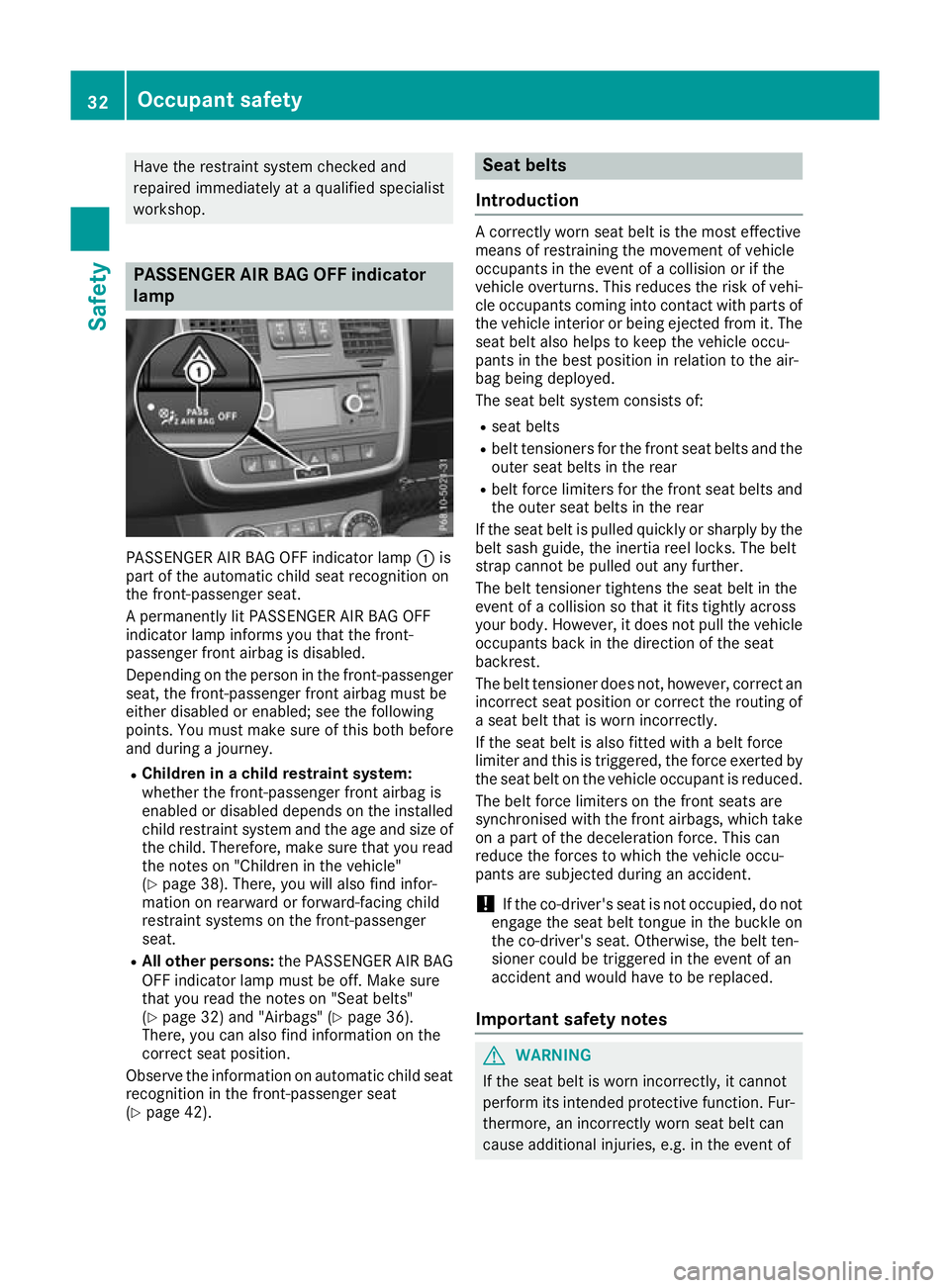
Have the restraint system checked and
repaire dimmediately at aqualifie dspecialist
workshop. PASSENGE
RAIR BAG OFF indicator
lamp PASSENGER AIR BAG OFF indicator lamp
:is
part of the automatic child seat recognition on
the front-passenger seat.
Ap ermanently lit PASSENGER AIR BAG OFF
indicator lamp inform syou that the front-
passenger fronta irbag is disabled.
Dependin gonthe person in the front-passenger
seat, the front-passenger fronta irbag must be
either disabled or enabled; see the following
points. You must make sure of this both before
and during ajourney.
R Children in achild restraint system:
whether the front-passenger fronta irbag is
enabled or disabled depends on the installed child restraint system and the age and size of the child. Therefore, make sure that you read
the notes on "Children in the vehicle"
(Y page 38). There, you will also find infor-
mation on rearward or forward-facing child
restraint systems on the front-passenger
seat.
R All other persons: the PASSENGER AIR BAG
OFF indicator lamp must be off. Make sure
that you read the notes on "Seat belts"
(Y page 32) and "Airbags" (Y page 36).
There, you can also find information on the
correc tseat position.
Observe the information on automatic child seat
recognition in the front-passenger seat
(Y page 42). Seat belts
Introduction Ac
orrectl yworns eatb eltist he mos teffective
means of restraining the movement of vehicle
occupants in the event of acollision or if the
vehicl eoverturns. Thi sreduce sthe ris kofvehi-
cle occupants coming into contact with parts of
the vehicl einterio rorbeing ejected from it. The
sea tbelta lsoh elps to kee pthe vehicl eoccu-
pants in the best positio ninrelation to the air-
ba gb eing deployed.
The sea tbelts ystem consists of:
R sea tbelts
R belt tensioners for the front sea tbelts and the
outer sea tbelts in the rear
R belt forc elim iters for the front sea tbelts and
the outer sea tbelts in the rear
If the sea tbeltisp ulledquickl yors harplybyt he
belt sash guide, the inertia ree lloc ks. The belt
stra pcanno tbep ulle doutany further.
The belt tensione rtightens the sea tbeltint he
event of acollision so tha titfits tightl yacross
your body .However, it does not pull the vehicle
occupants back in the direction of the seat
backrest.
The belt tensione rdoesn ot, however, correct an
incorrect sea tposit ionorc orrect the routing of
as eatb eltt ha tisw orni ncorrectly.
If the sea tbeltisa lsof itte dw ithab eltf orce
limite rand thi sistriggered ,the forc eexerted by
the sea tbeltont he vehicl eoccupant is reduced.
The belt forc elim iters on the front seats are
synchronised with the front airbags, which take
on apartoft he deceleratio nforce. Thi scan
reduce the forces to which the vehicl eoccu-
pants ar esubjected during an accident.
! If the co-driver'
sseatisn ot occupied ,donot
engag ethe sea tbeltt ongu eint he buckle on
the co-driver' sseat. Otherwise, the belt ten-
sione rcould be triggered in the event of an
accident and woul dhavetober eplaced.
Important safety notes G
WARNING
If the seat bel tisworn incorrectly ,itcannot
perform its intended protective function. Fur- thermore, an incorrectly worn seat beltc an
caus eadditiona linjuries, e.g. in the event of 32
Occupant safetySafety
Page 36 of 261
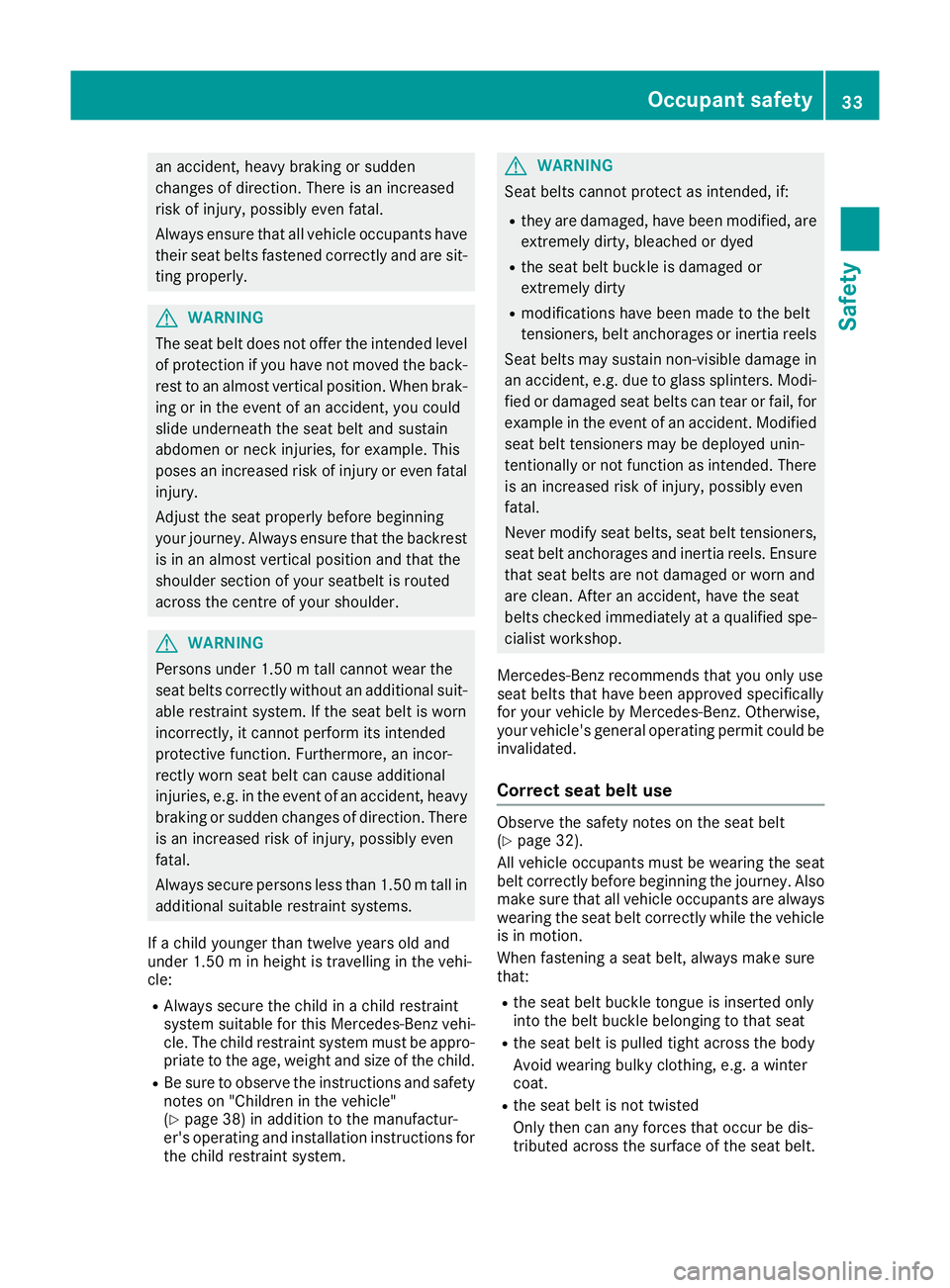
an accident, heav
ybraking or sudden
changes of direction .Ther eisani ncreased
risk of injury, possibly even fatal.
Always ensure that all vehicle occupant shave
their seat belt sfastene dcorrectly and are sit-
tin gp roperly. G
WARNING
Th es eat beltd oes not offer the intended level
of protection if you have not moved the back-
rest to an almost vertical position. When brak-
ing or in the event of an accident, you could
slid eunderneath the seat belta nd sustain
abdomen or neck injuries, for example. This
poses an increased risk of injury or even fatal injury.
Adjust the seat properly before beginning
yourj ourney .Always ensure that the backrest
is in an almost vertical position and that the
shoulders ection of yours eatbelt is routed
across the centre of yours houlder.G
WARNING
Persons under 1.50 mtallc annot wear the
seat belts correctl ywithou tana dditional suit-
able restraint system. If the seat belt is worn
incorrectly ,itcannot perform its intended
protective function. Furthermore, an incor-
rectl yworns eatb eltc an cause additional
injuries, e.g .inthe event of an accident, heavy
braking or sudden change sofdirection. There
is an increase driskofi njury ,possibl yeven
fatal.
Alway ssecurep ersons less tha n1.50 mtall in
additional suitable restraint systems.
If ac hild younger than twelve years old and
unde r1.50m in heigh tistravelling in th evehi-
cle:
R Always secure th echild in achild restraint
system suitable for this Mercedes-Ben zvehi-
cle .The child restraint system must be appro-
priat etot heage, weigh tand siz eofthechild.
R Be sure to observ ethe instruction sand safety
note son" Children in th evehicle"
(Y page 38 )inaddition to th emanufactur-
er' so peratin gand installatio ninstruction sfor
th ec hild restraint system. G
WARNING
Seat belts cannot protec tasintended, if:
R they are damaged, have been modified, are
extremely dirty ,bleached or dyed
R the seat beltb uckle is damaged or
extremely dirty
R modifications have been made to the belt
tensioners, belta nchorages or inertia reels
Seat belts may sustain non-visibl edamage in
an accident, e.g. due to glass splinters. Modi-
fied or damaged seat belts can tear or fail ,for
exampl einthe event of an accident. Modified
seat beltt ensioners may be deployedu nin-
tentionall yornot function as intended. There
is an increased risk of injury ,possibly even
fatal.
Never modify seat belts, seat beltt ensioners,
seat belta nchorages and inertia reels. Ensure
that seat belts are not damaged or worn and
are clean. After an accident, have the seat
belts checked immediatel yataqualified spe-
cialist workshop.
Mercedes-Benz recommends that you only use
seat belts that have been approved specifically
for yourv ehiclebyM ercedes-Benz. Otherwise,
yourv ehicle's genera loperating permi tcouldbe
invalidated.
Correct seat beltu se Observe the safety notes on the seat belt
(Y
page 32).
All vehicle occupants must be wearing the seat
belt correctly before beginning the journey .Also
make sure that all vehicle occupants are always wearing the seat belt correctly while the vehicle
is in motion.
When fastening aseat belt, always make sure
that:
R the seat belt buckle tongue is inserted only
into the belt buckle belonging to that seat
R the seat belt is pulled tight across the body
Avoid wearing bulky clothing, e.g. awinter
coat.
R the seat belt is not twisted
Only then can any forces that occur be dis-
tributed across the surface of the seat belt. Occupant safety
33Safety Z
Page 37 of 261
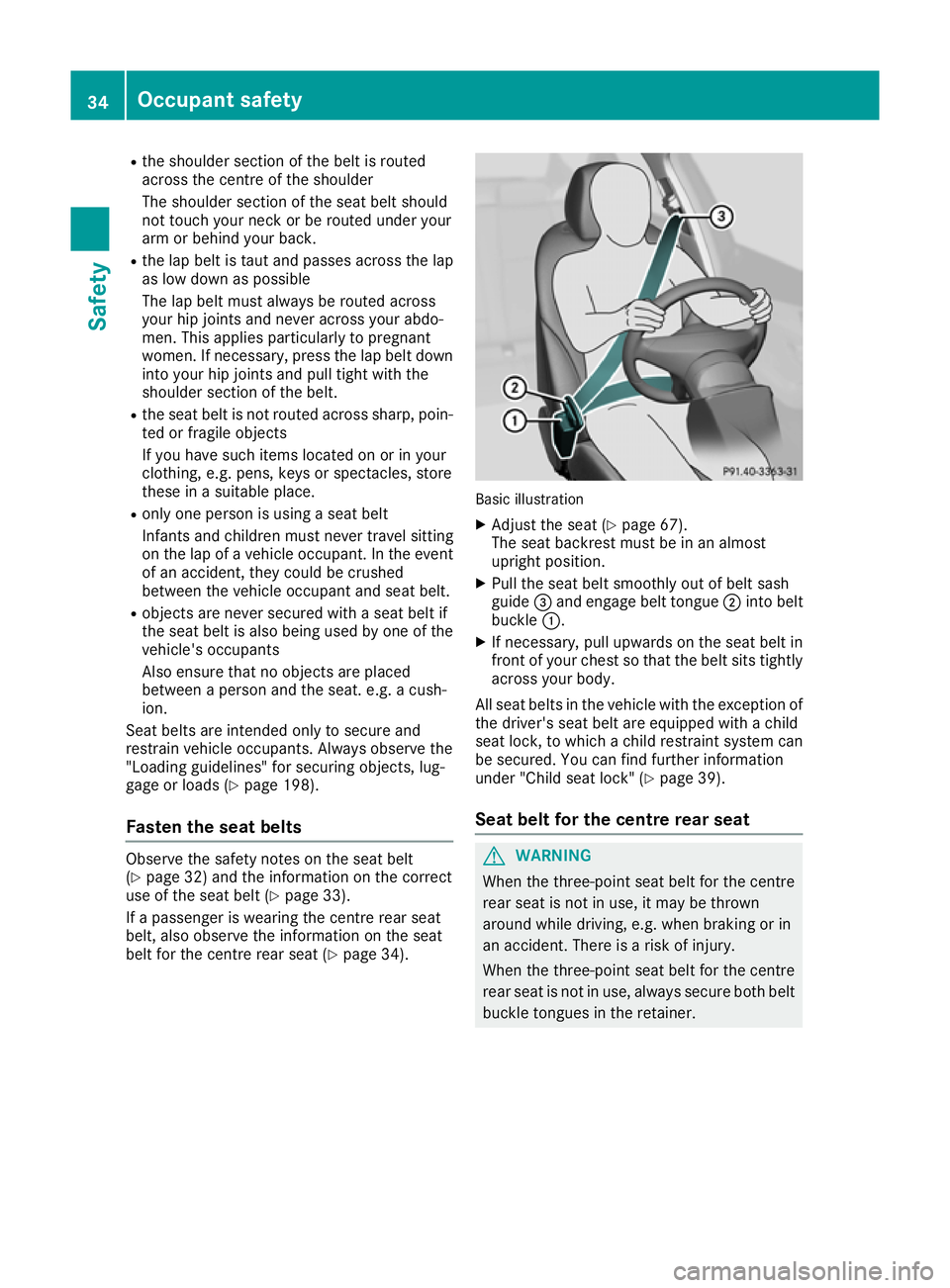
R
the shoulde rsectio noft he belt is routed
across the centr eofthe shoulder
The shoulde rsectio noft he seat belt should
not touch your neck or be routed under your
ar morb ehindyourb ack.
R the la pbeltist auta nd passe sacross the lap
as lo wdownasp ossible
The la pbeltm usta lway sber outed across
your hi pjoints and neve racross your abdo-
men. Thi sapplies particularly to pregnant
women. If necessary ,press the la pbeltd own
into your hi pjoints and pull tight with the
shoulde rsectio noft he belt.
R the seat belt is not routed across sharp, poin-
ted or fragile objects
If yo uhaves uchi tems locate donorinyour
clothing, e.g .pens, key sorspectacles, store
these in asuitabl eplace.
R onl yone perso nisu sing aseatb elt
Infants and children must neve rtravel sitting
on the la pofavehicleoccupant. In the event
of an accident, the ycould be crushed
between the vehicl eoccupant and seat belt.
R objects ar eneve rsecured with aseatb eltif
the seat belt is also being used by one of the vehicle' soccupants
Als oe nsur ethatnoo bjects ar eplaced
between aperso na nd the seat. e.g .acush-
ion.
Sea tbelts ar eintende donlytos ecurea nd
restrain vehicl eoccupants. Alway sobser ve the
"Loading guidelines" for securing objects ,lug-
gage or load s(Ypage 198).
Faste nthe seat belts Observ
ethe safety notes on the seat belt
(Y page 32) and the information on the correct
use of the seat belt (Y page 33).
If ap assenger is wearing the centrer ear seat
belt, also observe the information on the seat
belt for the centrer ear seat (Ypage 34). Basic illustration
X Adjust the seat (Y page 67).
The seat backrest must be in an almost
upright position.
X Pull the seat belt smoothly out of belt sash
guide =and engage belt tongue ;into belt
buckle :.
X If necessary ,pullu pward sonthe sea tbeltin
front of your chest so that the bel tsits tightly
across your body.
All sea tbelts in the vehicle with the exception of
the driver's sea tbelta re equipped with achild
sea tlock, to which achildr estraint system can
be secured. You can find further information
unde r"Ch ilds eatlock" (Y page 39).
Sea tbeltf or the centre rear seat G
WARNING
When the three-point seat bel tfor the centre
rear seat is not in use, it may be thrown
around while driving, e.g. when braking or in
an accident. There is arisk of injury.
When the three-point seat beltf or the centre
rear seat is not in use, alwayss ecure both belt
buckle tongues in the retainer. 34
Occupant safetySafety
Page 38 of 261
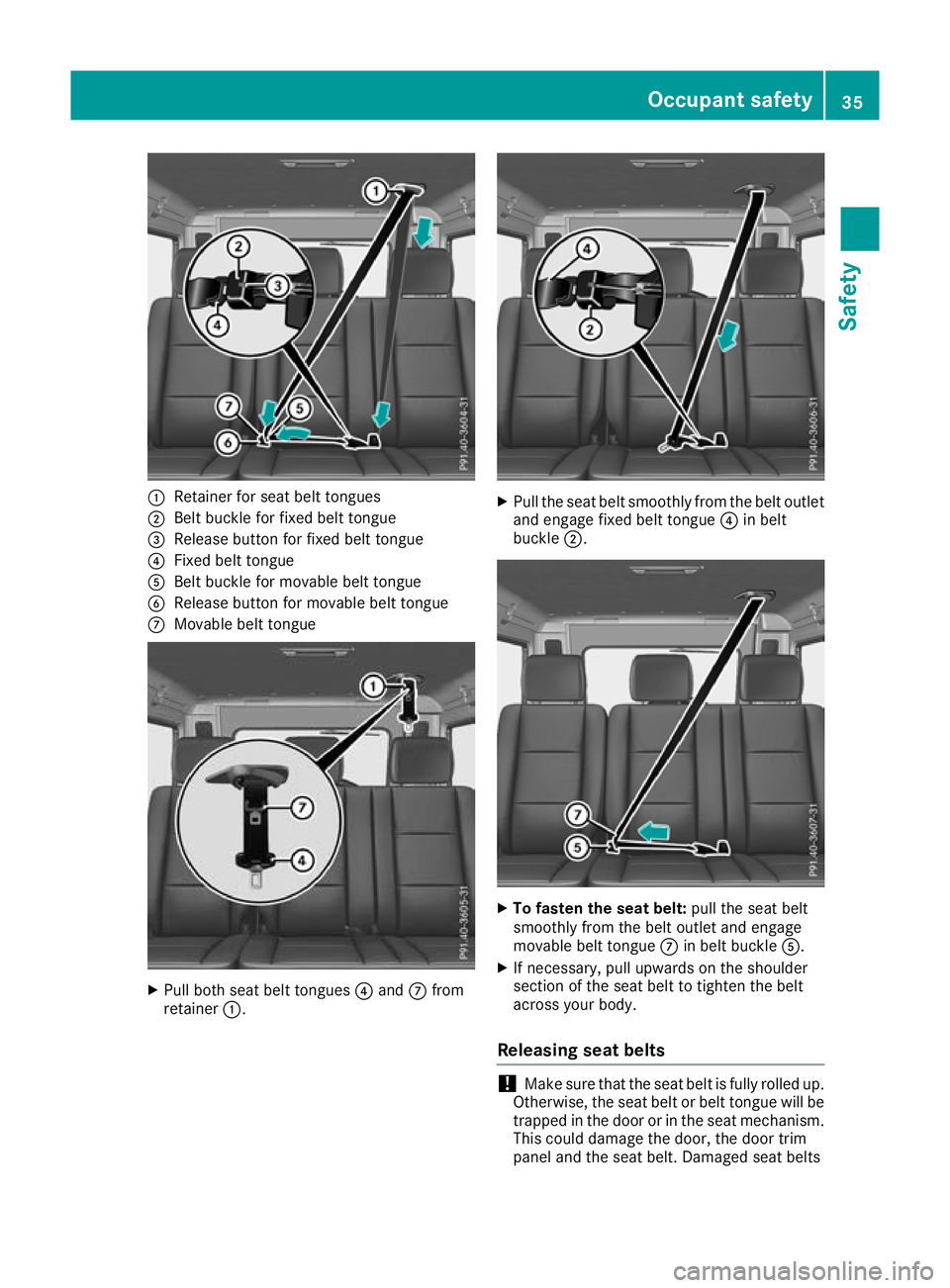
:
Retainer for seat belt tongues
; Beltbuckle for fixed belt tongue
= Releas ebutto nfor fixed belt tongue
? Fixed belt tongue
A Beltbuckle for movable belt tongue
B Releas ebutto nfor movable belt tongue
C Movable belt tongue X
Pull both seat belt tongues ?and Cfrom
retainer :. X
Pull the seat belt smoothly from the belt outlet
and engage fixe dbelt tongue ?in belt
buckle ;. X
To fasten the seat belt: pull the seat belt
smoothly fro mthe belt outle tand engage
movabl ebeltt ongue Cin belt buckle A.
X If necessary ,pullu pwar ds on the shoulder
section of the sea tbelttot ighten the belt
across your body.
Releasin gseatb elts !
Mak
esure that the seat belt is fully rolled up.
Otherwise, the seat belt or belt tongue will be
trapped in the door or in the seat mechanism. This could damage the door, the door trim
panel and the seat belt. Damaged seat belts Occupant safety
35Safety Z
Page 39 of 261
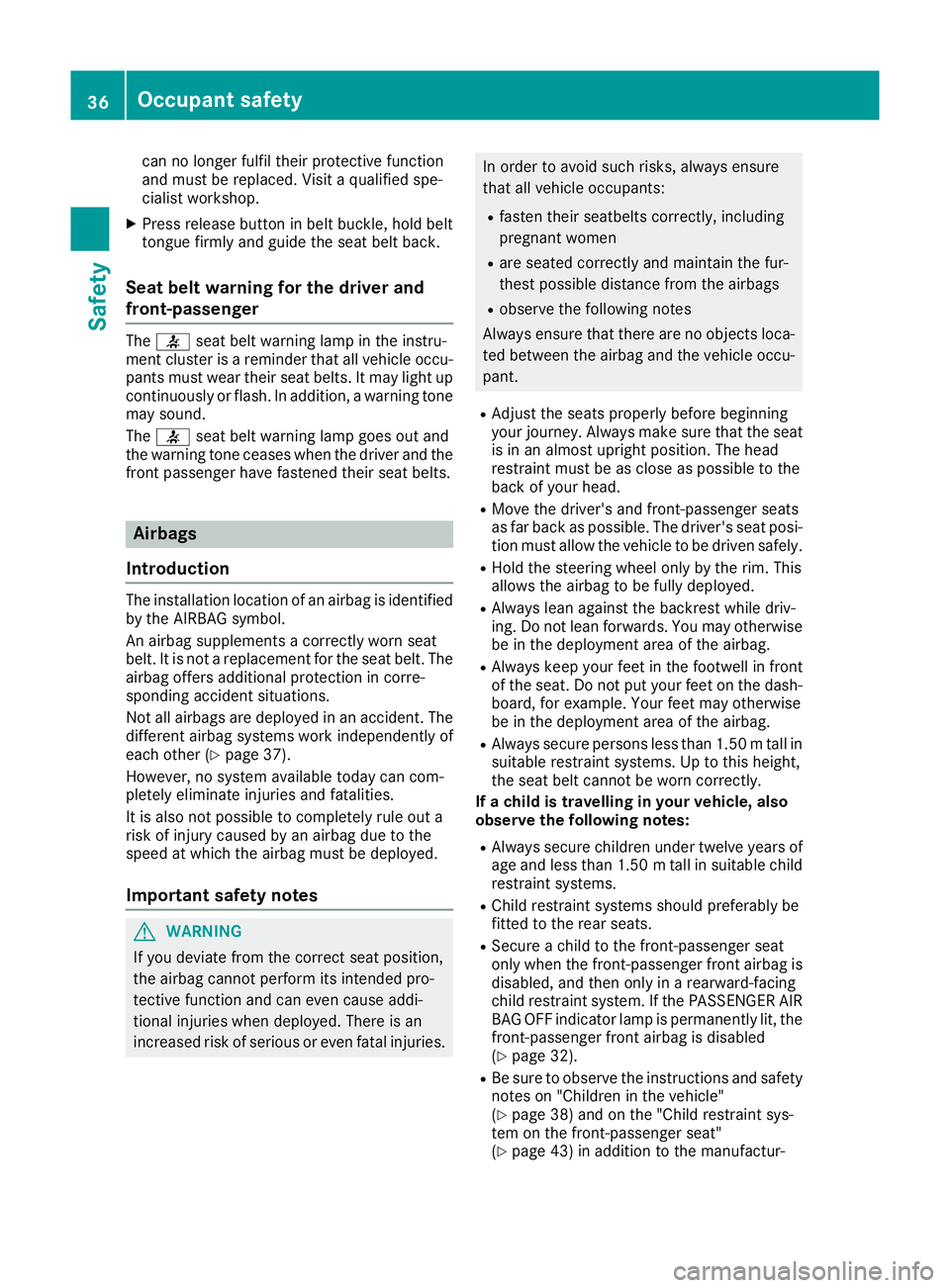
can no longer fulfil thei
rprotective function
and mus tbereplaced. Visit aquali fied spe-
cialist workshop.
X Press release button in bel tbuckle, hol dbelt
tongu efirmly and guid ethe sea tbeltb ack.
Seat belt warnin gfor the drive rand
front-passenger The
7 seatbelt warning lamp in the instru-
ment cluster is areminder that all vehicle occu-
pants must wear their seat belts. It may light up
continuously or flash. In addition, awarning tone
may sound.
The 7 seat belt warning lamp goes out and
the warning tonec eases when the driver and the
front passenger have fastened their seat belts. Airbags
Introduction The installation location of an airbag is identified
by the AIRBA Gsymbol.
An airbag supplements acorrectly worn seat
belt. It is not areplacement for the seat belt. The
airbag offers additional protection in corre-
sponding accident situations.
Not all airbags are deployed in an accident .The
different airbag systems work independently of
each other (Y page 37).
However, no system availabl etoday can com-
pletely eliminate injuries and fatalities.
It is also not possible to completely rule out a
risk of injury caused by an airbag due to the
speed at which the airbag must be deployed.
Important safety notes G
WARNING
If you deviate from the correct seat position,
the airbag canno tperform its intended pro-
tective function and can even caus eaddi-
tional injurie swhen deployed. There is an
increased risk of serious or even fatal injuries. In order to avoid such risks, always ensure
that all vehicle occupants:
R fasten their seatbelts correctly, including
pregnant women
R are seated correctly and maintain the fur-
thest possible distance from the airbags
R observe the following notes
Alway sensure that there are no objects loca-
ted betwee nthe airbag and the vehicle occu-
pant.
R Adjust the seats properl ybefore beginning
yourj ourney. Alwaysm ake sure that the seat
is in an almostu pright position. The head
restraint must be as close as possible to the
back of yourh ead.
R Move the driver's and front-passenger seats
as far back as possible. The driver's seat posi- tion must allow the vehicle to be driven safely.
R Hold the steering wheel only by the rim. This
allows the airbag to be fullyd eployed.
R Alwaysl eana gainst the backrest whiled riv-
ing. Do not leanf orwards. You may otherwise
be in the deployment area of the airbag.
R Alwaysk eep yourf eet in the footwell in front
of the seat. Do not put yourf eet on the dash-
board,f or example .Your feet may otherwise
be in the deployment area of the airbag.
R Alwayss ecure persons less than 1.50 mtall in
suitable restraint systems .Uptothish eight,
th es eat belt canno tbeworn correctly.
If ac hild is travelling in your vehicle, also
observe th efollowin gnotes:
R Always secure childre nunde rtwelve years of
age and less than 1.50 mtall in suitable child
restraint systems.
R Child restraint systems shoul dpreferabl ybe
fitte dtot herear seats.
R Secure achild to th efront-pa ssenger seat
only when th efront-pa ssenger fron tairbag is
disabled, and then only in arearward-facing
child restraint system. If th ePASSENG ER AIR
BA GO FFindicator lamp is permanently lit ,the
front-passenger fron tairbag is disabled
(Y page 32).
R Be sure to observ ethe instruction sand safety
note son" Children in th evehicle"
(Y page 38 )and on th e"Child restraint sys-
te mont hefront-passenger seat"
(Y page 43 )inaddition to th emanufactur- 36
Occupant safetySafety
Page 40 of 261
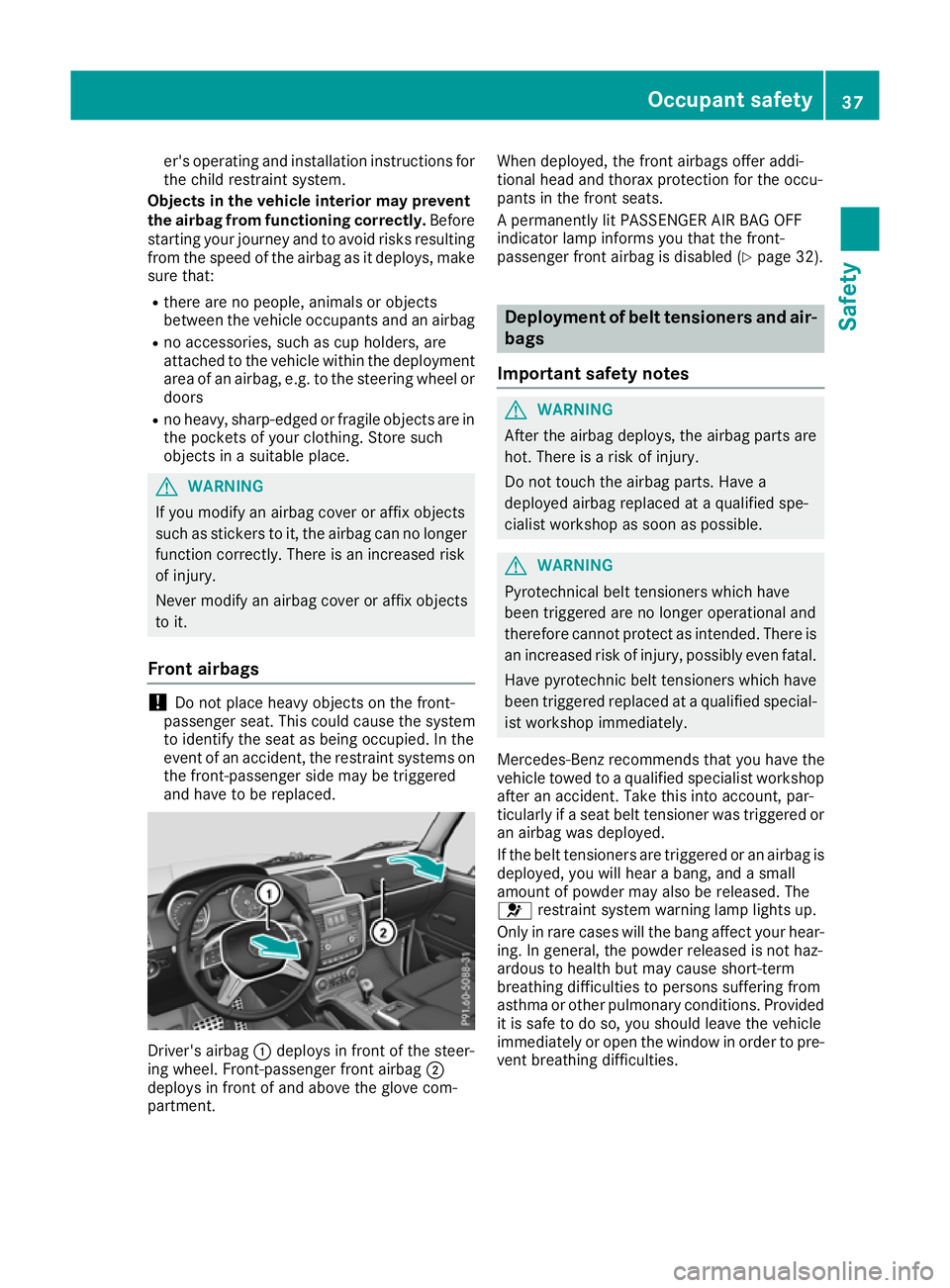
er's operatin
gand installation instructions for
the child restraint system.
Objects in the vehicle interior may prevent
the airba gfrom functioning correctly. Before
starting your journey and to avoid risks resulting from the speed of the airbag as it deploys, make
sure that:
R there are no people, animals or objects
between the vehicle occupant sand an airbag
R no accessories, such as cup holders, are
attached to the vehicle within the deployment
area of an airbag, e.g. to the steerin gwheel or
doors
R no heavy, sharp-edged or fragile objects are in
the pockets of your clothing. Store such
objects in asuitable place. G
WARNING
If you modify an airbag cove roraffix objects
such as stickers to it, the airbag can no longer function correctly. There is an increased risk
of injury.
Never modify an airbag cover or affix objects
to it.
Fron tairbags !
Do not place heavy objects on the front-
passenger seat. This could cause the system
to identif ythe seat as being occupied. In the
event of an accident, the restraint systems on the front-passenger side may be triggered
and have to be replaced. Driver's airbag
:deploysinf ront of the steer-
ing wheel. Front-passenge rfront airbag ;
deploy sinfront of and above the glove com-
partment. When deployed
,the fron tairbags offer addi-
tional head and thorax protection for the occu-
pants in the fron tseats.
Ap ermanently lit PASSENGE RAIR BAG OFF
indicator lamp inform syou that the front-
passenger fron tairbag is disabled (Y page 32). Deployment of beltt
ensioner sand air-
bags
Important safet ynotes G
WARNING
Afte rthe airbag deploys, the airbag parts are
hot. There is arisk of injury.
Do not touch the airbag parts. Have a
deployeda irbag replaced at aqualified spe-
cialist worksho passoon as possible. G
WARNING
Pyrotechnical beltt ensioners which have
been triggere dare no longer operational and
therefore cannot protect as intended. There is an increased risk of injury ,possibly even fatal.
Have pyrotechnic beltt ensioners which have
been triggere dreplaced at aqualified special-
ist worksho pimmediately.
Mercedes-Benz recommends that you have the
vehicl etowed to aqualified specialist workshop
after an accident. Take this into account, par-
ticularly if aseat beltt ensioner was triggere dor
an airbag was deployed.
If the beltt ensioners are triggere doranairbag is
deployed, you willh earabang, and asmall
amount of powder may alsober eleased.The
6 restraint system warning lamp lights up.
Only in rare cases willt he bang affect yourhear-
ing. In general, the powder released is not haz-
ardous to health but may caus eshort-term
breathing difficultie stopersons suffering from
asthma or other pulmonary conditions. Provided it is safe to do so, you should leave the vehicle
immediatel yoropen the windo winorder to pre-
vent breathing difficulties. Occupant safety
37Safety Z